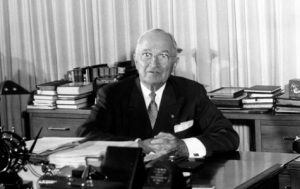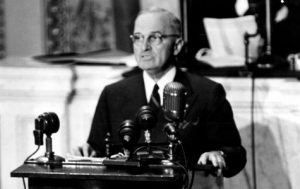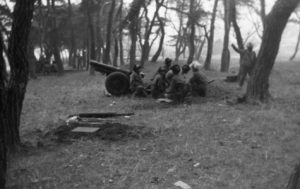
Harry S. Truman, the 33rd President of the United States, spent much of his two terms in office rewriting the playbook on how this country would engage with the world for generations to come. Truman’s philosophies established some of the basic principles that marked American foreign policy for the remainder of the twentieth century. His policies, certainly with regard to the state of the Middle East and our dealings with North Korea through the fall of the Soviet Union, still resonate today.
When Truman succeeded Franklin Delano Roosevelt after an unprecedented three terms guiding this country through some of the grimmest times of the 20th century, World War II in Europe was almost over. Within a month, Germany surrendered. In the Pacific, however, the last Axis power standing, Japan, would prove a formidable and relentless foe bent on expelling American forces from the region at any cost. Military planners anticipated that total victory would require an Allied invasion of Japan. The invasion plan would extend the war for at least another year and it would likely come at a terrible cost in casualties and treasure. Discouraged with that scenario, Truman explored another option.
The scientists at the top-secret Manhattan Project, a research and development undertaking during World War II, were diligently at work attempting to complete an atomic bomb. By July 1945, a test of the bomb was deemed successful. With this ‘nuclear option’ at his disposal, the outlook of bringing the war to a swift conclusion seemed like a reality. With the daunting prospect of a full-scale invasion of the Japanese home islands and an obdurate Japanese leadership refusing to abide by the terms of unconditional surrender, Truman’s forced hand gave the green light to drop atomic bombs on their adversary. After two Japanese cities, Nagasaki and Hiroshima, were decimated by the previously unforeseen power of these weapons, the Japanese agreed to surrender and World War II was officially history.
At the Yalta conference in February 1945, shortly before Germany had been defeated, the United States, the United Kingdom and the Soviet Union met in the Crimean Peninsula to discuss how they would carve up, essentially, post-war Europe. They were to author a plan that would establish peace across the continent and empower the previously occupied countries to determine the fate and futures of their respective governments. Never really intending on going through with his word, Joseph Stalin, the leader of the Soviet Union, established a Communist stronghold in Poland that signaled the eventual installation of puppet, Soviet-controlled governments across Eastern Europe for years afterward. The future of Germany, the boundaries of postwar Poland, and the nature of wartime reparations were separated by a gulf of drastically different points of view shared by the United States and the Soviet Union. It began to be painfully clear to Truman and British Prime Minister Winston Churchill that the long term aims of the Soviet Union was to blanket Europe with their unflinching brand of Marxist-Leninist ideology in what Churchill would dub, the ‘iron curtain.’

The United States continued to go about its business of aiding and repairing war torn countries like England and Germany by providing financial aid and a strong military presence. The idea that other European countries could be swayed to adopt a Communist, pro-Soviet government was of major concern and brought about another milestone foreign policy of the Truman administration – the Truman Doctrine. The doctrine stated that “free peoples who are resisting attempted subjugation by armed minorities or by outside pressures ” deserved the unwavering support of the U.S. government. To add teeth to this piece of policy, Secretary of State George Marshall became the steward of a multi-billion dollar European aid program that bore his name – the Marshall Plan. This aggressive distribution of funds across Europe would, ideally speaking, stave off the Soviet efforts to unduly influence other nations and endear those peoples to the American cause.
The inevitable incursion of Soviet power into a sovereign country occurred in 1948 when they rolled their tanks into Czechoslovakia. As a reaction to Soviet hostility, Truman won congressional approval of the Marshall Plan and the United States, England, and France – each in control of a particular German zone, circled their wagons and merged those zones into what would be designated West Germany. The Soviets countered by blockading western access routes to Berlin. Truman, determined not to abandon the city, ordered an airlift of food and fuel to break the blockade.
The Soviets would rescind the blockade on the condition that everyone return to the negotiating table to hammer out Germany’s future. The sides were unable to come to an amicable agreement after the Soviets refused the British and American proposal of transforming the Soviet zone in Germany into a democratic republic. As a result, the country would remain divided between West and East until 1990. Due to the Soviet acts of aggression of invading Czechoslovakia and causing a confrontation with the Berlin incident, an alliance between the United States, Canada, and Western Europe was formed under the moniker of NATO, or the North Atlantic Treaty Organization. Shortly before the new decade, Europe found itself divided down ideological, economic and military lines.

The United Nations’ most significant accomplishment to that point would come at the outset of the Korean War. In the wake of Japanese capitulation in the Pacific theater and their subsequent expulsion from the Korean Peninsula, The Soviet Union, in an action commensurate with their having declared war on Japan previously, set up shop in the northern region of the country. American top military brass was dispatched to the country in an effort to divide it into zones under the control of both the Soviet Union and the United States. The line of demarcation came to be known as the 38th Parallel. In June of 1950, North Korea, behind their military leader Kim-Il-sung and with the support of China and the Soviet Union, invaded South Korea.
Immediately, the act was condemned by the United Nations and Truman got busy with enacting an appropriate response. Learning from the past mistake of appeasing and approving of Hitler’s expansionism, Truman knew that in order to project strength and a commitment to a democratic form of government, the U.S. had to fight back militarily. Led by WWII hero General Douglas MacArthur, the U.S. military ultimately drove back the enemy troops back across the 38th Parallel. Emboldened by their success, Truman ordered MacArthur to pursue the North Korean army all the way to the Chinese/Russian border and reunify the country. The Chinese, true to their word, entered the fray and beat back the Americans south of the 38th parallel. After ending in 1953, the Korean War proved to be a bloody stalemate. Because an American victory was never achieved, Harry Truman’s approval rating took a pretty big hit and he became a subject of relentless criticism by the political party on the other side of the aisle.
By 1952, Harry Truman announced that he would not seek reelection and proceeded to ready himself for a life in the private sector. Much of his two terms were embroiled in wars in far off lands as he attempted to spread the virtues of democracy all over the globe. The deep rift between the Soviet Union and the United States, that had its beginnings under Truman, was inevitable and the chilly diplomatic relations between the countries over their diametrically opposed ideological views came to be known as the Cold War. In 1953, Harry and his wife, former First Lady Bess Truman, traveled by train from Washington to their home in Independence, Missouri. There, he lived quietly until his death in 1972. He loved to meet with the occasional visitor when he wasn’t occupied with the writing of his memoirs, remodeling every room in the house and his daily brisk walks. This return home and the simple and unfussy manner in which he conducted himself is why Harry S. Truman will always be known as the ‘People’s President.’